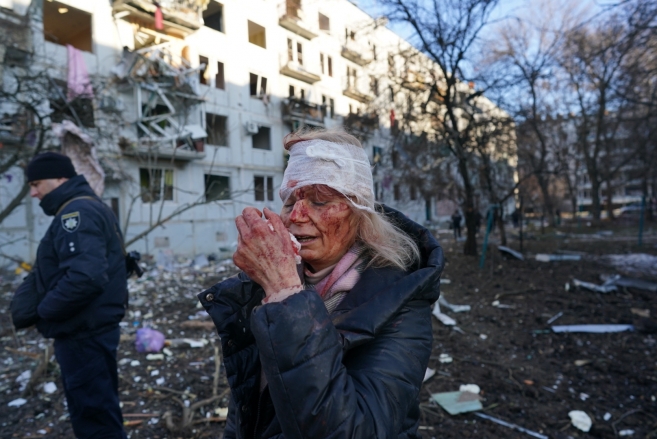Ukraine: Use of explosive weapons will be disastrous for civilians
24 February 2022
The military invasion of Ukraine, including use of heavy explosive weapons in and around major cities and other populated areas, raises grave concerns over the protection of the civilian population.

CHUHUIV, UKRAINE – FEBRUARY 24: A wounded woman is seen after an airstrike damaged an apartment complex in city of Chuhuiv, Kharkiv Oblast, Ukraine on February 24, 2022. (Photo by Wolfgang Schwan/Anadolu Agency via Getty Images)
“The use of explosive weapons including airstrikes, multiple launch rocket systems, missiles, and bombs near major towns and cities poses a grave and foreseeable risk of death and injury to civilians, including harm from damage and destruction to vital civilian infrastructure and essential services”, warns Laura Boillot, Coordinator of the International Network on explosive Weapons (INEW).
“INEW calls on all parties to stop the use of heavy explosive weapons in towns, cities and other populated areas due to the high risk of harm to civilians”, she added.
The intensification of conflict in recent days has been accompanied by the use of explosive weapons, including airstrikes, MLRS Grad rockets, missiles, and mortars, endangering civilian lives. The OSCE Special Monitoring mission has reported a sharp increase in explosions over recent days including over 1,400 explosions on 23 February 2022 alone.
The situation is unfolding rapidly, with widespread reports of explosions and rising numbers of civilian casualties. Some incidents of concern include: shelling in residential areas that injured at least 4 civilians and damaged homes and civilian infrastructure in the Donbas region in Ukraine; Human Rights Watch reports that a school on the contact line in Donbas was hit, with one of the shells landing in the kindergarten’s recreation room; shelling that struck Shchastya Power plant and two major pumping stations in the Dontesk region that serve over 1 million people with potable water and were rendered inoperable.
The use of explosive weapons with wide area effects in populated areas poses a grave and foreseeable risk to civilians, resulting in death, injuries and psychological harm, and destroys homes, hospitals, schools and vital infrastructure and services upon which civilians rely. Explosive remnants of war pose an ongoing threat to civilians during and after hostilities and impedes the safe return of refugees and displaced persons. Designed for use in open battlefields, explosive weapons have shown a consistent pattern of harm over the past decade with a devastating civilian casualty rate of 90% when used in the context of populated areas such as towns and cities.
Armed conflict in Ukraine – where artillery shelling has been reported on a regular basis over the past eight years – has been deadly for civilians, who account for 89% of casualties caused by explosive weapons. The conflict has caused over one million people to flee and has left much of the region’s housing and infrastructure severely degraded, regularly leaving people without water, gas or power for days and weeks on end.
Parties to conflict have an obligation to uphold international law and to protect the civilian population, including from harms caused by damage to and destruction of vital civilian infrastructure and services.
